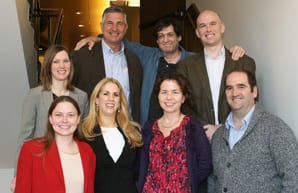As taxpayers make the final push to file before the April 15 deadline, they often have visions of refund checks and plans to spend their windfall. But the question that more and more people are asking is, “How can I make the most of my refund?” 
Finding answers to this question is the goal of an innovative research initiative headquartered in the Center for Social Development (CSD) at the Brown School at Washington University in St. Louis. Under the leadership of CSD Associate Director Michal Grinstein-Weiss, PhD, CSD has joined forces with Dan Ariely, PhD, the James B. Duke Professor of Behavioral Economics at Duke University, and with corporate partner Intuit, Inc., a leader in the tax preparation industry.
The Refund to Savings initiative, expected to reach nearly 1.2 million households during the current tax season, is the largest savings experiment conducted in the United States. The experiment is seamlessly woven into Intuit’s TurboTax Freedom Edition product, which is free for low- and moderate-income taxpayers. As part of the normal tax preparation using the Freedom Edition software, taxpayers see a motivational message prompting them to set aside part of their refund into savings, a suggested default savings amount, and an easy-to-use mechanism that will split their refund between spending and savings.
“This project is taking research to a new level,” Grinstein-Weiss says. “We are combining academic research with a private industry platform to come up with a real, practical solution that encourages savings.”
The project partners and other collaborators from numerous public and private entities met at the Brown School in early March to discuss insights from the experiment to date and to consider new ideas to test in the coming years. Attendees represented the federal government – including the Consumer Finance Protection Bureau, Department of the Treasury, FDIC and Federal Reserve Bank – as well as project funders, and policy and advocacy organizations. Even with the broad range of perspectives attendees brought to the table, one primary goal remained consistent: To take what they learn through this initiative and turn it into a universal policy that will increase financial stability, particularly for the most economically vulnerable populations.
“It was wonderful to see the excitement and engagement in the room during the meeting,” Grinstein-Weiss says. “We’re trying to find a scalable intervention that can inform policy—that is, a program that will work on a national scale, that can be offered to all taxpayers—and I can’t envision a better team to make that vision become a reality. The ideas from this meeting will help shape Refund to Savings in particular, and hopefully savings policy overall, for years to come.”
One common theme discussed at the meeting was the personalization of the intervention, allowing prompts and other materials to speak specifically to each taxpayer’s situation. For instance, the software could capture a dependent’s name and ask specifically about creating a savings account for the dependent’s education. Or the program might remind a taxpayer with a new job that opening a 401k will not only help build retirement savings for the future but this deduction could result in a larger refund.
The Refund to Savings partners plan to move forward by identifying the most promising ideas from their brainstorming sessions, analyzing data from the current tax season, and determining the most appropriate ways to design interventions and test outcomes in future projects.
This year’s Refund to Savings intervention will be evaluated using responses to the in-product offer as well as responses to the Household Financial Survey (HFS). The HFS is an Internet-based survey that taxpayers will be asked to complete immediately after filing their taxes and again six months later. The purpose of the survey is to learn what motivated taxpayers’ decisions when they chose a savings-to-spending ratio, and whether their decision to save had an impact on household finances. Initially, the researchers expected 12,000 taxpayers to complete the HFS, but due to an overwhelming response rate, the final number will likely be close to 20,000. At this sample size, the HFS will be one of the largest data sets collected regarding the finances of the low- and moderate-income population.
Grinstein-Weiss says American families have reached a near-historic low rate of savings, which places families at great risk for financial disaster when faced with sudden job loss or an unexpected expense. “Developing easy ways to help taxpayers automatically save a portion of their refund is one of the most promising opportunities to increase financial security for millions of Americans,” she says.